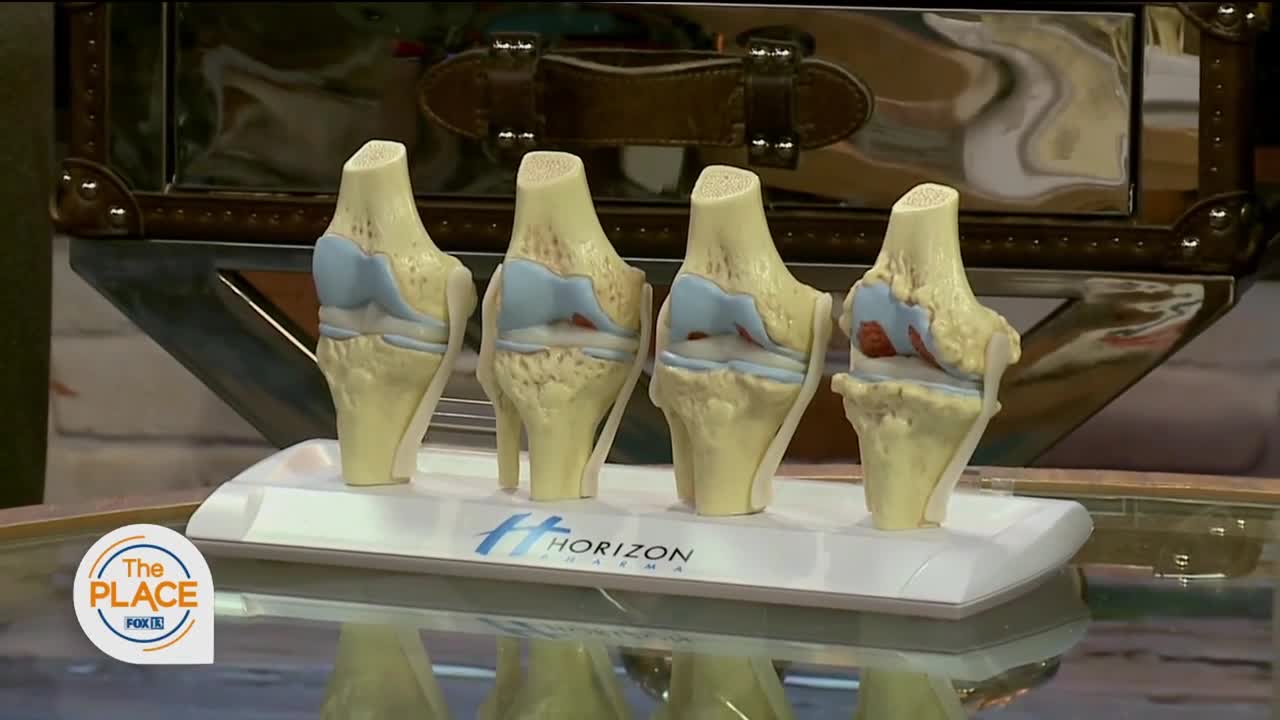Do you have painful arthritis in your knees? Is it affecting the quality of your life? Are you considering total joint replacement? Dr. Spencer Amundsen – a fellowship-trained and board-certified orthopedic surgeon with Peak Orthopaedics, located on the campus of MountainStar Healthcare’s Lone Peak Hospital – joined FOX13’s The PLACE on Monday to discuss some of the most frequently asked questions he receives about knee health and surgical options to address knee pain.
Dr. Amundsen is passionate about taking the time to make sure each patient completely understands their diagnosis and all available treatment options. He specializes in total joint replacement, including adult reconstruction of the knee and hip. Dr. Amundsen is also certified in robotic hip and knee surgery.
What is arthritis and what causes the condition?
According to the Centers for Disease Control and Prevention (CDC), arthritis affects about 53 million people in the U.S.
“The majority of people have osteoarthritis and that just means the cartilage is wearing out or breaking down the joint for an unknown reason – probably genetic in origin,” explained Dr. Amundsen.
Osteoarthritis (OA) is the most common type of arthritis that is caused by cartilage degeneration, leading to bone-on-bone friction and pain. Osteoarthritis causes joint pain, stiffness, and swelling—usually in the hands, hips, back, or knees. Over time, it can lead to changes in bone, cartilage, and other joint tissues—resulting in disability or making it extremely difficult for someone to perform daily tasks.
Factors that increase the risk for osteoarthritis include:
- Repetitive joint stress or injury
- Obesity
- Family history
- Older age
- Gender
Women are more likely to develop arthritis than men, especially after the age of 50.
What is a total knee replacement?
A total knee replacement – also known as “knee arthroplasty” – is a surgical procedure that removes damaged portions of the knee and replaces them with artificial parts, typically made of metal and plastic. The operation is performed to alleviate pain and improve function in the knee.
“A knee replacement consists of making an incision to expose the joint, removing the arthritic bone, and replacing it with a combination of metal, plastic, and ceramic. At the end, we close up the skin with dissolvable stitches, some glue, and a waterproof dressing,” explained Dr. Amundsen. “Sometimes, it’s the best way to restore your joint health.”
Dr. Amundsen says it is important that patients have a clear understanding of what will happen during and after any surgery, including and especially any kind of joint replacement. He wants patients to be comfortable and confident. Knee replacement, he says, usually involves a much smaller and more compact area of the knee/leg than people expect.
“Knee replacement probably could have been called ‘knee resurfacing’ because what we do is shave down a little bit of bone and the remaining cartilage and put a metal cap on the femur, a metal cap on the tibia, and a piece of plastic in between,” Dr. Amundsen said.
The typical knee replacement procedure could take anywhere from an hour to an hour and a half to complete, depending on the complexity of the case.
Robotics are used at Peak Orthopaedics for hip replacements, knee replacements and for partial knee replacements. Dr. Amundsen utilizes robotics for these joint replacements.
“I think robotics really has two big advantages: accuracy and precision,” Dr. Amundsen said. “Instead of it being kind of an eyeballed procedure, we’re looking at angles, computer screens, and it really has turned it into a more reliable procedure.”
Studies have shown that patients undergoing robotic knee replacement tend to report higher satisfaction levels compared to traditional methods.
How do I know when it’s time to have my knee replaced?
“My opinion is that there’s two conditions—an objective condition: do you have arthritis on an x-ray? The second is a subjective condition: are you unsatisfied with your life?”
Whether it’s someone’s frustration with not being able to engage in physical activities – playing with grandkids the way they’d like, playing tennis the way they used to, or taking much longer to get daily chores done at home, for example – if knee pain and discomfort is affecting your quality of life, Dr. Amundsen says it’s probably time to schedule an office visit.
“I’d recommend people come see me whenever they’re having discomfort or pain in their knee,” Dr. Amundsen exclaimed. “It could be that they already know they need a joint replacement or maybe they just would like to know what’s going on and get some information. We can do imaging. We can do a physical exam. We can help them identify who needs to have surgery and who can be managed nonoperatively.”
Partial knee replacements are only indicated when 1/3 of the knee is worn out, and the other 2/3 look good. If more than 1/3 of the knee is worn out, a partial knee replacement may not be possible. A total knee replacement would be required if all cartilage in the knee is worn out.
RELATED: Back on the bike thanks to Peak Orthopaedics & MountainStar Healthcare’s Lone Peak Hospital
“The choice to have a joint replacement or when to have a joint replacement is when you decide enough is enough,” he said. “Everybody’s a little bit different when they arrive at that point. When you reach a point where you’re not happy, then let’s do something about it. Let’s change that!”
Recovering from a knee replacement
“It probably takes a year to a year and a half to get all the way better from a knee replacement, but most of that recovery probably takes place in the first three months. So, it’s kind of slow and painful at the start, and then you’ll get rapidly better as time goes on,” Dr. Amundsen said. “Physical therapy is one of the keys to recover from this surgery.”
The majority of patients can go home from the hospital after undergoing a knee replacement the same day they have the procedure performed.
“We get people up and walking within hours of surgery, whether it's a hip replacement, a knee replacement, or a partial knee replacement. That translates into a faster recovery at every level,” Dr. Amundsen continued.
Hospital physical therapists create a personalized therapy regimen for patients to help them use the affected knee.
Many patients are driving a car two weeks after surgery. Many patients are back at work anywhere from two to six weeks after surgery, depending on the level of physical fitness required for their job.
“A successful joint replacement is very much dependent on the recovery process and it takes a lot of ownership–on the patient's part–for that to happen. To go to physical therapy, to talk to me if they're having difficulty with pain control, and to come and visit with me so that I can help,” Dr. Amundsen said.
Pain control is something that many people worry about and oftentimes it delays patients from seeing a surgeon. For anyone concerned with pain control associated with joint replacement surgery, Dr. Amundsen says don’t hesitate to book an appointment with him.
“The good news is that there are a lot of newer strategies to deal with pain control beyond just taking narcotics,” Dr. Amundsen said. “These include multimodal pain control, which includes a variety of different medications that can be taken, as well as procedures that can either be done before or after joint replacement to minimize the amount of pain that someone feels.”
Further, Dr. Amundsen said, “My goal is to work with the patient throughout the postoperative period to make sure that their pain is well managed. If something's not working well, we can change it. We can modify it. But our strategy needs to be a tolerable level of pain so they can successfully work with physical therapy.”
Knee specialists like Dr. Amundsen provide their patients with postoperative care instructions. On average, he says he’d hope to get 20 years or more out of a knee replacement.
About Spencer Amundsen, MD
Dr. Spencer Amundsen is a fellowship trained and board-certified orthopedic surgeon practicing at the Peak Orthopaedics clinic in Draper. Dr. Amundsen graduated from the University of Utah School of Medicine before finishing his orthopedic training at three Ivy League universities, including: Dartmouth, Harvard and Cornell – the top ranked hospital in the country for orthopedics.
Originally from Sandy, Utah, Dr. Amundsen specializes in total joint replacement including adult reconstruction of the hip and knee. He is also certified in robotic hip and knee surgery with extensive training in anterior approach hip replacement. He prides himself in offering patients the most up-to-date orthopedic treatment options. In his free time, Dr. Amundsen loves downhill skiing, mountain biking, rock climbing and riding dirt bikes. He was part of the Brighton High School state champion soccer team in 1999 and has also competed in multiple U.S. downhill skiing and ski jumping competitions throughout his life. He and his wife are proud parents of four children.
Services Offered at Peak Orthopaedics
Each physician – skilled orthopedic surgeons and sports medicine specialists, alike – at the Peak Orthopaedic Clinic has been trained in their specific area of joint care.
Every service includes individualized care plans with both surgical and nonsurgical joint care options for every area of the body, including:
- Foot and ankle surgery
- Hand, wrist and elbow surgery
- Hip surgery
- Knee surgery
- Shoulder surgery
- Sports medicine
If you haven't experienced adequate relief with medication and other conservative treatments, knee specialists with MountainStar Healthcare can help. They offer partial and total knee replacements to relieve chronic knee pain caused by injury or disease, such as arthritis. Through knee replacement surgery and their comprehensive rehabilitation program, you can return to your active lifestyle.
Peak Orthopaedics at Lone Peak Hospital
96 Kimballs Lane, Building 3, Suite 207
Draper, UT 84020
Phone: (801) 576-2300
Peak Orthopaedics offers same day consults with a joint specialist for all new injuries. You can be seen today or the very next business day. For more information about this clinic, visit PeakOrthoClinic.com.
To learn more about knee replacement, click here.
Lone Peak Hospital is one of eight MountainStar Healthcare hospitals in Utah.



